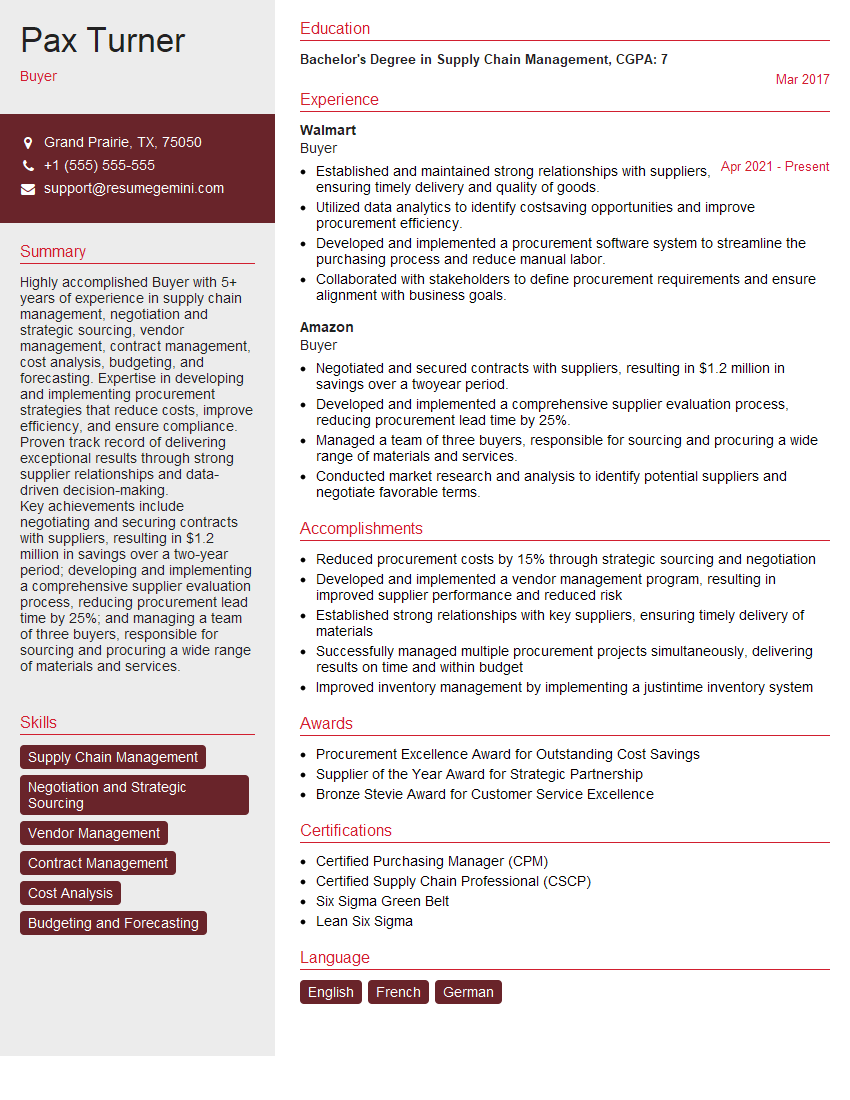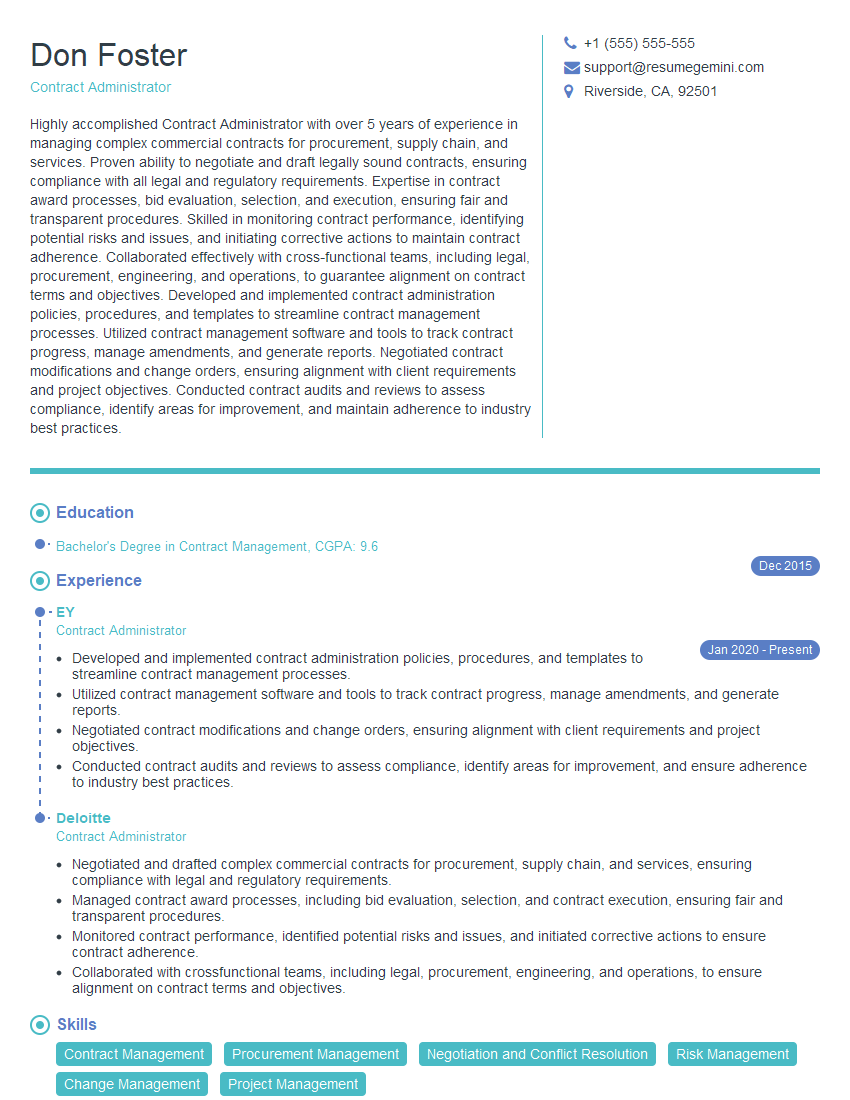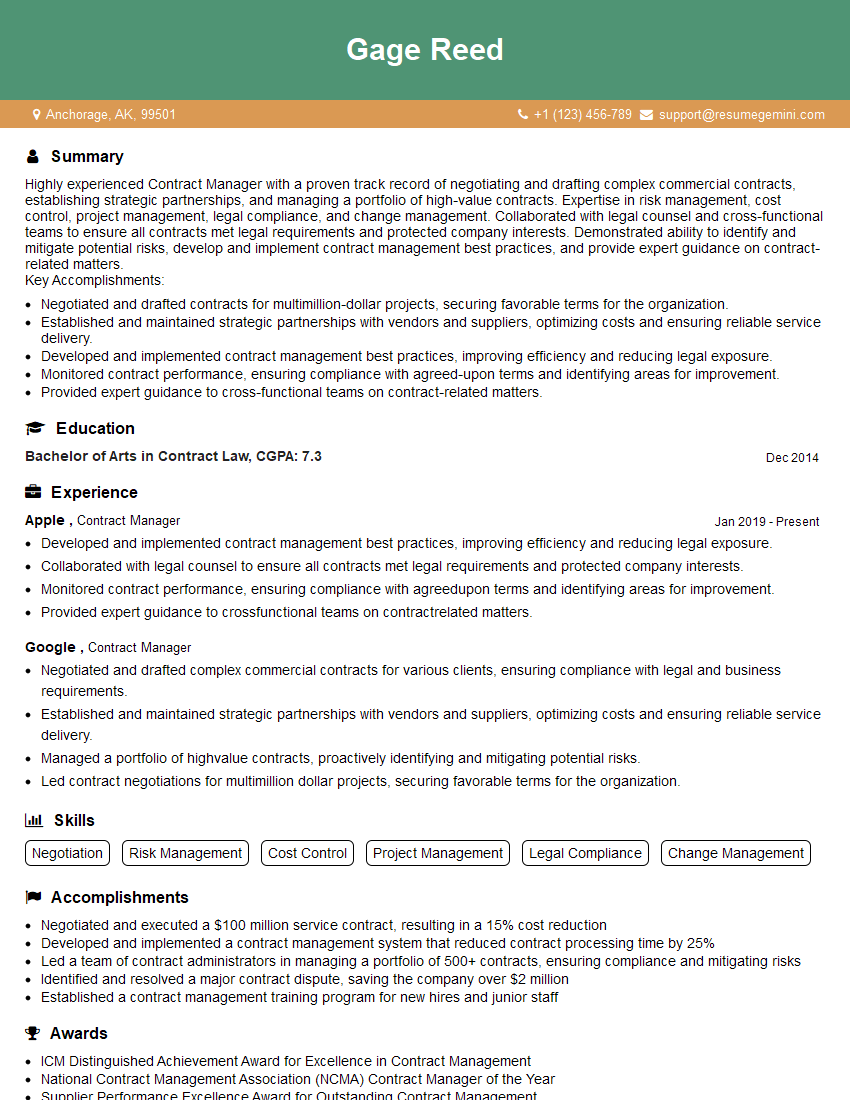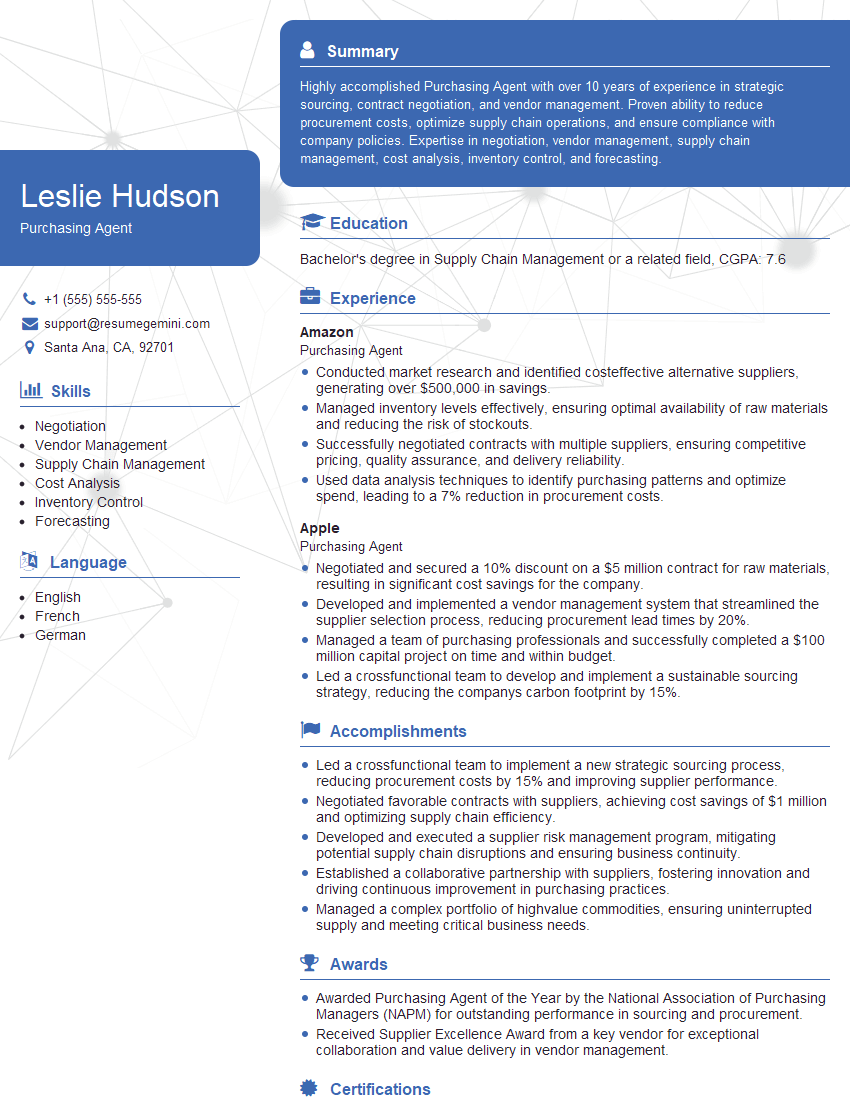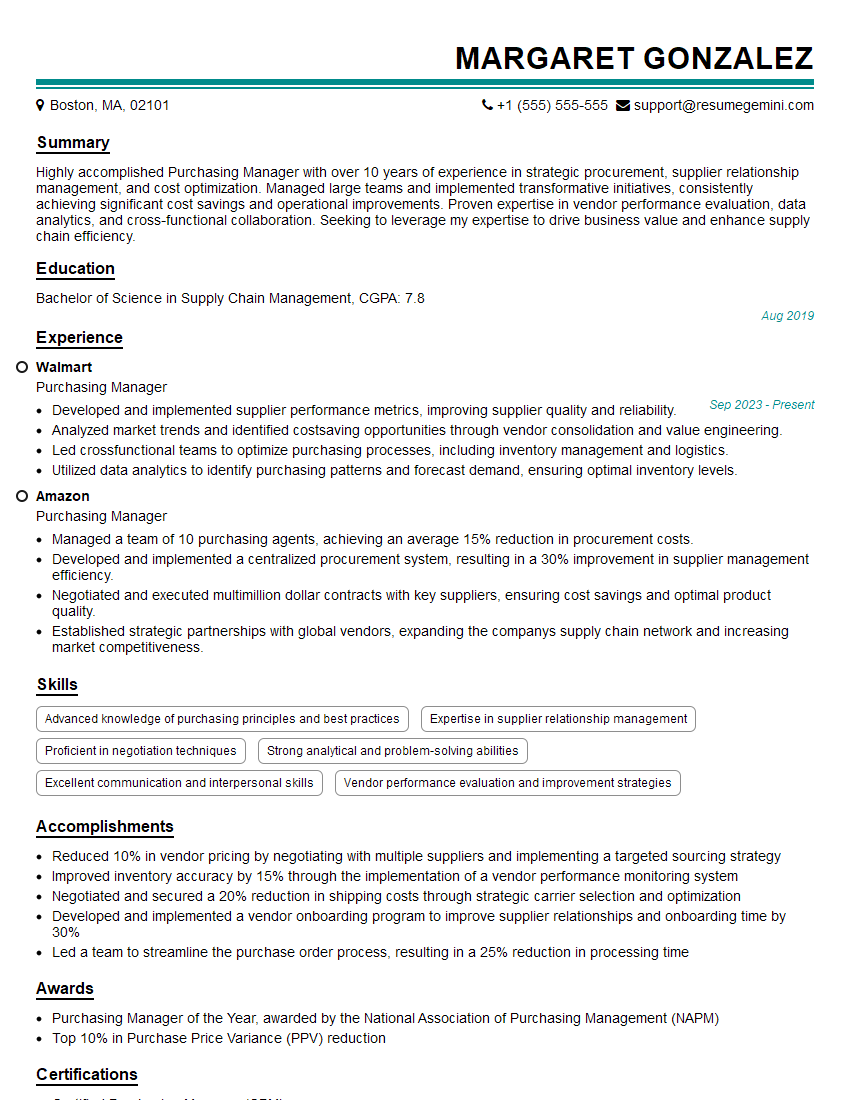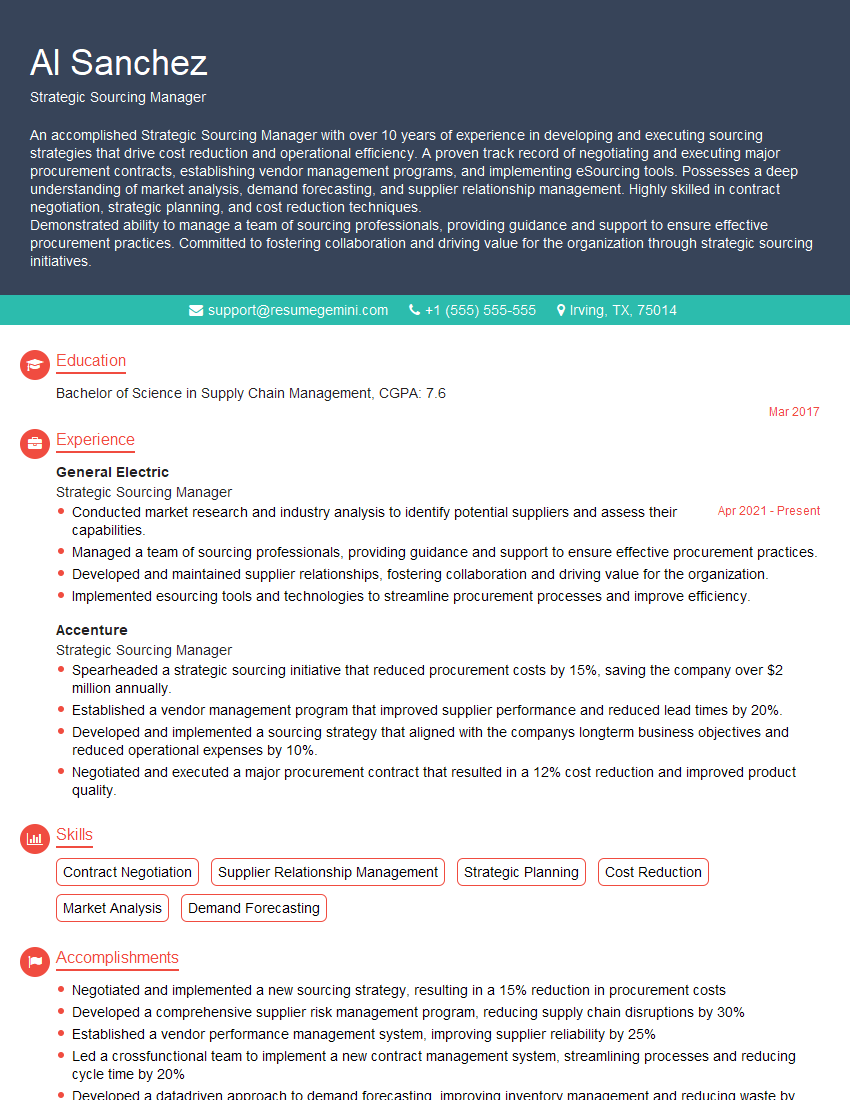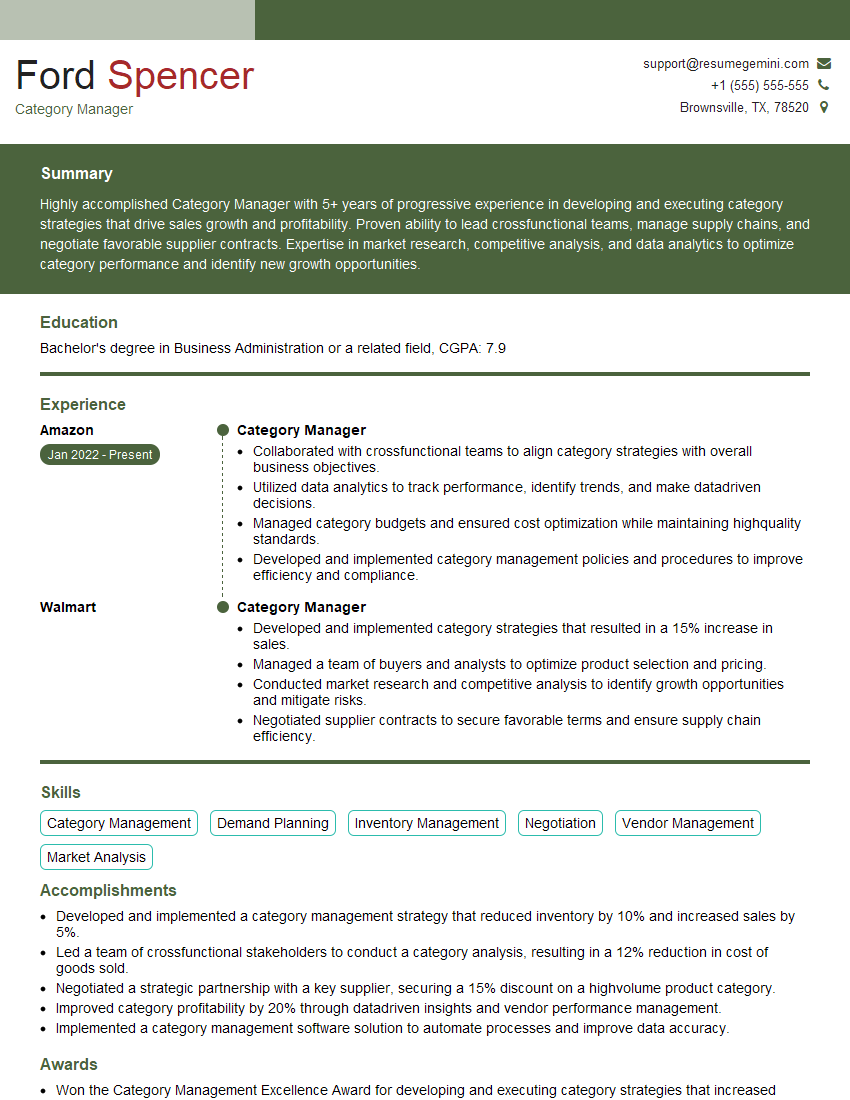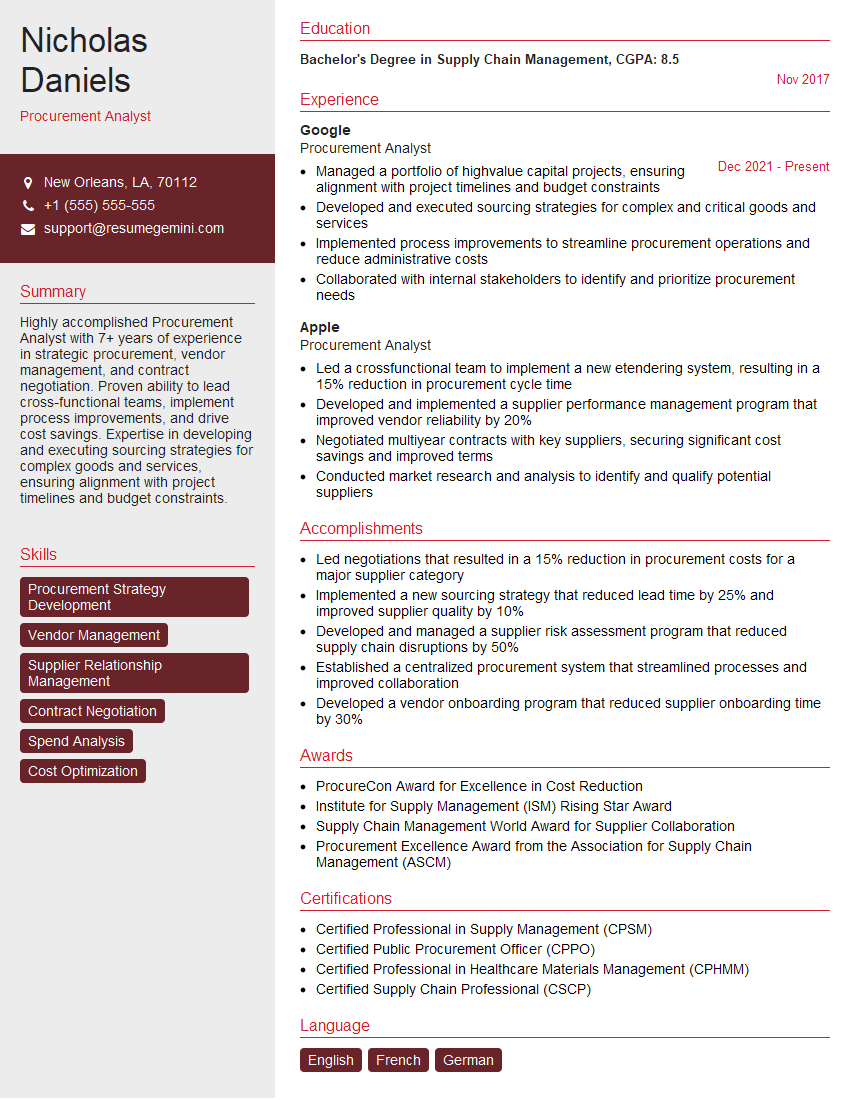Preparation is the key to success in any interview. In this post, we’ll explore crucial Experience in working with vendors interview questions and equip you with strategies to craft impactful answers. Whether you’re a beginner or a pro, these tips will elevate your preparation.
Questions Asked in Experience in working with vendors Interview
Q 1. Describe your experience managing vendor contracts.
Managing vendor contracts involves a multifaceted approach that goes beyond simply signing agreements. It’s about establishing clear expectations, mitigating risks, and ensuring both parties benefit from a mutually beneficial partnership. My experience encompasses the entire lifecycle, from initial negotiation and drafting to ongoing monitoring and renewal.
- Negotiation and Drafting: I meticulously review contracts, paying close attention to service level agreements (SLAs), payment terms, intellectual property rights, and termination clauses. I leverage my negotiation skills to secure favorable terms while maintaining positive vendor relationships. For instance, in a recent project, I successfully negotiated a lower price point by highlighting the long-term commitment we offered.
- Contract Execution and Monitoring: Once the contract is signed, I establish a system for tracking deliverables, milestones, and performance against the agreed-upon SLAs. This often involves regular meetings and progress reports. I utilize project management software to ensure transparent communication and effective oversight.
- Contract Renewal and Termination: Before contract renewal, I conduct a thorough performance review, evaluating whether the vendor consistently met their obligations and if the terms remain optimal. If the performance is unsatisfactory, I initiate a performance improvement plan. In cases of serious breaches, I follow established processes for contract termination, ensuring legal compliance.
Q 2. How do you identify and mitigate risks associated with vendor relationships?
Identifying and mitigating risks associated with vendor relationships is crucial for business continuity and success. My approach involves a proactive, multi-stage process:
- Due Diligence: Before engaging a vendor, I conduct comprehensive due diligence, including thorough background checks, financial stability assessments, and references checks. This helps to identify potential red flags early on.
- Risk Assessment: I perform a detailed risk assessment, focusing on areas such as financial risk, operational risk, security risk, and compliance risk. This typically includes identifying potential vulnerabilities and developing mitigation strategies.
- Contractual Safeguards: Contracts serve as critical tools for risk mitigation. I incorporate specific clauses to address potential risks, including SLAs, indemnification provisions, and dispute resolution mechanisms. For example, a strong SLA with clear consequences for non-compliance encourages timely delivery and performance.
- Monitoring and Review: Ongoing monitoring is essential. Regular performance reviews and communication help identify emerging risks and implement corrective actions proactively. Unexpected events such as supply chain disruptions or natural disasters may require contingency plans already in place.
Q 3. Explain your process for selecting and onboarding new vendors.
My process for selecting and onboarding new vendors is structured to ensure a smooth and efficient transition. It involves several key stages:
- Needs Assessment: I begin by clearly defining the organization’s needs and requirements. This ensures that the vendor selection process is targeted and effective.
- Vendor Identification and Evaluation: I identify potential vendors through various channels, such as industry directories, online searches, and referrals. A detailed evaluation matrix is then used to assess vendors based on pre-determined criteria, including cost, quality, experience, and reputation.
- Request for Proposal (RFP) Process: For significant engagements, a formal RFP process is used to solicit proposals from shortlisted vendors. This allows for a standardized comparison of bids and ensures transparency.
- Vendor Selection and Negotiation: Based on the evaluation of proposals and further discussions, a vendor is selected, and the contract is negotiated.
- Onboarding: A comprehensive onboarding process is implemented, including training sessions, system access setup, and clear communication channels. Regular check-ins during the initial phase ensure a smooth integration.
Q 4. What metrics do you use to measure vendor performance?
Measuring vendor performance is crucial to ensuring accountability and driving improvement. The specific metrics depend on the nature of the service, but I typically focus on a combination of quantitative and qualitative measures:
- Quantitative Metrics: These include on-time delivery rates, completion rates, cost adherence, defect rates, and customer satisfaction scores (CSAT). I use dashboards and reports to visually track these metrics over time.
- Qualitative Metrics: These assess aspects like communication responsiveness, problem-solving abilities, collaboration effectiveness, and adherence to company values. Regular feedback sessions and performance reviews are instrumental in gathering this data.
- Key Performance Indicators (KPIs): I identify critical KPIs that align with overall business objectives and use them to monitor vendor performance. These KPIs might include things like cost savings achieved, cycle time reductions, or improvements in customer satisfaction.
By regularly monitoring these metrics and providing feedback, I can ensure consistent performance and identify areas for improvement.
Q 5. How do you handle vendor performance issues?
Handling vendor performance issues requires a structured and professional approach. My strategy involves:
- Early Identification: Proactive monitoring helps identify performance issues early, before they escalate into major problems. Regular communication and feedback sessions are key.
- Performance Improvement Plan (PIP): For recurring or significant issues, I work collaboratively with the vendor to develop a PIP. This document outlines specific expectations, timelines, and support mechanisms to help the vendor address the deficiencies.
- Escalation Process: If the PIP is unsuccessful, I escalate the issue through established channels, involving relevant stakeholders within both organizations. This may involve formal warnings or even contract termination.
- Documentation: Throughout the process, detailed documentation of communications, agreements, and performance data is maintained. This ensures accountability and provides a clear record of events.
My goal is always to find a collaborative solution that benefits both parties. However, I am prepared to take decisive action when necessary to protect the organization’s interests.
Q 6. Describe a time you had to negotiate a better contract with a vendor.
In a previous role, we were using a software vendor whose contract renewal price was significantly higher than expected. Instead of automatically accepting the increased cost, I initiated a thorough review of the contract and market rates for similar services.
I researched alternative vendors and discovered several companies offering comparable services at significantly lower prices. Armed with this information, I approached the original vendor with a counter-proposal, highlighting our findings. I presented data showcasing the competitive landscape and negotiated a revised contract with a 15% reduction in the annual fee, while simultaneously securing improvements to their service level agreement.
This successful negotiation not only saved the company a considerable sum of money but also demonstrated the importance of proactive contract management and leveraging market intelligence.
Q 7. How do you build and maintain strong relationships with vendors?
Building and maintaining strong vendor relationships is critical for long-term success. It’s about fostering mutual trust, respect, and open communication. My approach includes:
- Regular Communication: I schedule regular meetings with key vendor contacts to discuss progress, challenges, and opportunities for improvement. This proactive communication prevents misunderstandings and fosters collaboration.
- Relationship Building: I invest time in getting to know the people I work with. This personal connection fosters trust and strengthens the working relationship. Small gestures of appreciation, such as acknowledging milestones or achievements, go a long way.
- Collaborative Problem Solving: When issues arise, I work collaboratively with vendors to identify solutions. A joint problem-solving approach strengthens the relationship and builds mutual respect.
- Open and Honest Feedback: I provide both positive and constructive feedback regularly, creating a culture of continuous improvement. This helps vendors understand our expectations and adjust their processes accordingly.
- Fair and Ethical Practices: Maintaining ethical and fair practices is paramount. This includes adhering to payment terms, respecting intellectual property rights, and treating vendors with professionalism.
Q 8. What is your experience with vendor relationship management (VRM) software?
My experience with Vendor Relationship Management (VRM) software encompasses both implementation and utilization. I’ve worked with several platforms, including Coupa and SAP Ariba, to streamline vendor onboarding, contract management, performance tracking, and communication. For example, at my previous role, we implemented Coupa to centralize all vendor interactions. This resulted in a 20% reduction in processing time for invoices and improved visibility into vendor performance. The software’s features, such as automated workflows and reporting dashboards, significantly enhanced our efficiency and provided valuable data-driven insights into our vendor relationships. My experience goes beyond simply using the software; I’ve also participated in the selection process, configuring the system to meet specific organizational needs, and training other team members on its usage.
Q 9. How do you ensure vendor compliance with company policies and regulations?
Ensuring vendor compliance is crucial. My approach is multi-faceted and begins with a robust onboarding process that clearly outlines our company policies and regulatory requirements, including data security, ethical sourcing, and environmental standards. We use a combination of methods:
- Clear Contractual Agreements: Contracts explicitly state compliance expectations, outlining consequences for non-compliance.
- Regular Audits and Monitoring: We conduct periodic audits, both internal and potentially third-party, to verify compliance and identify potential risks.
- Training and Communication: Vendors receive regular updates on policy changes and best practices through workshops, online training modules, and direct communication.
- Performance Metrics: Compliance is tracked as a key performance indicator (KPI) in vendor performance reviews, directly influencing future contracts.
Q 10. Describe your experience with RFP (Request for Proposal) processes.
I have extensive experience with RFP processes, from drafting the RFP document itself to evaluating proposals and negotiating contracts. My approach focuses on clarity and efficiency.
- Defining Clear Requirements: The RFP starts with meticulously defined requirements, including scope of work, deliverables, timelines, and success metrics. This clarity prevents misunderstandings and ensures that proposals are relevant.
- Structured Evaluation Criteria: We develop a scoring system based on weighted criteria, such as price, experience, technical capabilities, and compliance. This ensures a fair and objective evaluation.
- Effective Communication: Maintaining clear and consistent communication with prospective vendors throughout the process is paramount. This includes promptly addressing questions and providing timely feedback.
- Vendor Shortlisting and Interviews: We often shortlist vendors for further interviews to assess their understanding of the requirements and their team’s capabilities.
Q 11. How do you evaluate vendor proposals?
Evaluating vendor proposals requires a structured and objective approach. We use a standardized rubric aligned with the RFP’s criteria. This ensures consistency and minimizes bias.
- Qualitative Assessment: We assess the vendor’s understanding of our needs, proposed solutions, experience, and references. This qualitative assessment looks beyond simply numbers.
- Quantitative Analysis: We analyze pricing, timelines, and resource allocation. Detailed cost breakdowns are essential to ensure transparency and value for money.
- Risk Assessment: We identify potential risks associated with each proposal, considering factors such as project complexity, vendor stability, and potential legal issues.
- Reference Checks: We always contact previous clients to verify the vendor’s performance and reliability.
Q 12. How do you manage vendor payment processes?
Vendor payment processes are managed meticulously to ensure accuracy, efficiency, and compliance. We leverage a combination of automated systems and manual checks to maintain transparency and prevent errors.
- Centralized System: We utilize a centralized system for tracking invoices, payments, and reconciliation. This provides a single source of truth for all vendor-related financial data.
- Automated Workflows: Automated workflows expedite invoice processing and payment approvals, reducing manual intervention and potential delays.
- Three-Way Matching: We employ a three-way matching process to verify that the invoice, purchase order, and receiving report align before payment is released.
- Regular Reconciliation: Regular reconciliation of vendor accounts ensures the accuracy of financial records and identifies any discrepancies promptly.
Q 13. How do you handle vendor disputes?
Handling vendor disputes requires a proactive and collaborative approach. Our goal is to resolve issues fairly and efficiently, preserving the relationship whenever possible.
- Formal Communication Channels: We establish clear communication channels to report and discuss disputes, providing a structured pathway for resolution.
- Escalation Process: A defined escalation process helps to manage disputes efficiently, involving relevant stakeholders when necessary.
- Mediation or Arbitration: In complex or intractable disputes, mediation or arbitration may be utilized to achieve a neutral resolution.
- Documentation: Maintaining detailed documentation of all communication, agreements, and resolutions is crucial in case of future disputes.
Q 14. How do you ensure data security and confidentiality when working with vendors?
Data security and confidentiality are paramount when working with vendors. We implement robust measures to protect sensitive information.
- Data Security Agreements (DSAs): We require all vendors to sign DSAs that outline their responsibilities for protecting our data, complying with relevant regulations such as GDPR and CCPA.
- Background Checks and Vetting: We conduct background checks and security assessments of vendors, especially those handling sensitive data.
- Access Control: We implement strict access control measures to limit vendor access to only necessary data and systems.
- Regular Security Audits: Regular security audits and penetration testing are conducted to identify and address vulnerabilities.
- Data Encryption: Data is encrypted both in transit and at rest to ensure its confidentiality.
Q 15. What is your experience with different vendor types (e.g., IT, manufacturing, services)?
My experience spans a wide range of vendor types, including IT, manufacturing, and various service providers. In my previous role at Acme Corp, I managed relationships with over 50 vendors, encompassing software developers (IT), component manufacturers (manufacturing), and marketing agencies (services). Each type requires a tailored approach. For instance, IT vendors necessitate a strong focus on technical specifications, SLAs (Service Level Agreements), and security protocols. Manufacturing vendors require meticulous quality control and supply chain management, while service providers focus on deliverables, timelines, and client satisfaction. Understanding the nuances of each industry is key to effective vendor management.
- IT Vendors: Negotiating contracts with cloud providers (AWS, Azure), managing software licenses, and ensuring cybersecurity compliance.
- Manufacturing Vendors: Overseeing production schedules, inspecting incoming goods, and managing inventory levels.
- Service Vendors: Monitoring performance against KPIs (Key Performance Indicators), managing budgets, and ensuring adherence to project scopes.
Career Expert Tips:
- Ace those interviews! Prepare effectively by reviewing the Top 50 Most Common Interview Questions on ResumeGemini.
- Navigate your job search with confidence! Explore a wide range of Career Tips on ResumeGemini. Learn about common challenges and recommendations to overcome them.
- Craft the perfect resume! Master the Art of Resume Writing with ResumeGemini’s guide. Showcase your unique qualifications and achievements effectively.
- Don’t miss out on holiday savings! Build your dream resume with ResumeGemini’s ATS optimized templates.
Q 16. Describe your experience with vendor performance reviews.
Vendor performance reviews are a critical part of maintaining strong vendor relationships and ensuring optimal performance. My approach is multifaceted and data-driven. I start by defining clear KPIs, aligned with the vendor’s contract and our business objectives. These KPIs can include on-time delivery, quality metrics, response time, and cost efficiency. Then, I collect data from various sources – monthly reports, feedback surveys, and internal performance data. I then conduct regular review meetings with vendor representatives, going over the data, highlighting areas of strength and weakness, and collaboratively creating action plans for improvement. Following the review, I document findings and create a formal performance report, which serves as a basis for future negotiations and contract renewals.
For example, if a manufacturing vendor consistently fails to meet delivery deadlines, the review would identify this as a critical issue. The action plan might involve investigating root causes (e.g., capacity constraints, supply chain issues), negotiating revised deadlines, or even considering alternative vendors if necessary.
Q 17. How do you track and manage vendor invoices?
Tracking and managing vendor invoices requires a structured and systematic approach to ensure accuracy and timely payments. I utilize a combination of automated systems and manual processes. We use an enterprise resource planning (ERP) system to record all invoices, which automatically generates alerts for due dates and potential discrepancies. Before processing payments, I meticulously verify invoices against purchase orders, contracts, and received goods or services. Any inconsistencies are flagged and investigated to prevent erroneous payments. Furthermore, we maintain a centralized database of all vendor invoices, enabling easy tracking and reporting on spending. This system helps identify potential payment delays, negotiate better payment terms with vendors, and maintain an accurate record of financial transactions.
We also leverage automated invoice processing tools to reduce manual effort and increase efficiency. These tools use optical character recognition (OCR) to extract invoice data automatically, minimizing human error and saving time.
Q 18. What is your experience with vendor diversity initiatives?
Vendor diversity initiatives are crucial for fostering a fair and inclusive business environment. My experience involves actively seeking out and supporting diverse vendors, including women-owned businesses, minority-owned businesses, and veteran-owned businesses. This includes actively researching and participating in relevant supplier diversity programs, attending industry events focused on diverse suppliers, and building relationships with organizations that support and certify diverse businesses. When evaluating vendors, I ensure that our evaluation criteria incorporate diversity considerations. While price and quality are crucial, we also assess the vendor’s commitment to diversity and inclusion.
In one project, I consciously sought out a woman-owned software development firm, contributing to their growth and fulfilling our commitment to diversity.
Q 19. How do you ensure vendors meet sustainability requirements?
Ensuring vendors meet sustainability requirements is a growing priority. I incorporate environmental, social, and governance (ESG) criteria into vendor selection and performance evaluations. This includes assessing vendors’ environmental policies, waste management practices, carbon footprint, and ethical sourcing practices. Before engaging a vendor, we review their sustainability reports and certifications (e.g., ISO 14001). Contracts often include clauses that explicitly require vendors to adhere to our sustainability guidelines. Regular monitoring and reporting mechanisms ensure compliance. Non-compliance can result in penalties or contract termination. We also prioritize vendors who demonstrate a genuine commitment to sustainability and continuously strive for improvement.
For example, we might require vendors to use recycled materials, reduce their energy consumption, and implement waste reduction programs.
Q 20. What is your approach to managing vendor communication?
Effective vendor communication is the cornerstone of a successful vendor relationship. My approach emphasizes clarity, consistency, and proactive communication. I establish clear communication channels (email, phone, video conferencing) and maintain a regular communication cadence. This ensures transparency and minimizes misunderstandings. I utilize project management tools to centralize communication and track progress. Furthermore, I strive to build personal relationships with key contacts at each vendor. This personal touch helps foster trust and facilitates quick resolution of issues.
For example, regular project status calls help identify and address potential problems proactively, avoiding costly delays.
Q 21. How do you handle urgent requests or issues from vendors?
Handling urgent vendor requests or issues requires a swift and decisive response. I prioritize these requests based on their impact on our business operations. I establish a clear escalation path for urgent matters, ensuring that the right people are notified promptly. I utilize communication tools like instant messaging or phone calls for immediate updates and problem-solving. The goal is to quickly diagnose the issue, find a solution, and keep all stakeholders informed. Following the resolution, I document the issue, the solution implemented, and any lessons learned to prevent similar situations in the future.
For example, if a critical software vendor experiences an outage, immediate action is required to minimize disruption. This would involve contacting the vendor’s support team, escalating the issue to their senior management if needed, and exploring contingency plans in parallel.
Q 22. How do you manage multiple vendor relationships simultaneously?
Managing multiple vendor relationships effectively requires a structured approach. Think of it like orchestrating a complex symphony – each vendor plays a crucial role, and they need to be harmonized to achieve the desired outcome. I utilize a robust system combining technology and personal interaction.
- Centralized Vendor Management System: I rely on a centralized platform to track key performance indicators (KPIs), contracts, communication logs, and payment schedules for each vendor. This ensures transparency and efficient monitoring.
- Regular Communication: Consistent and clear communication is paramount. I schedule regular meetings, utilize project management software, and maintain open lines of communication to address issues proactively. For example, weekly check-ins with key vendors ensure alignment on project goals and the timely resolution of any emerging challenges.
- Prioritization and Delegation: I prioritize vendors based on criticality and urgency. Where possible, I delegate tasks to capable team members, ensuring clear responsibilities and accountability.
- Relationship Building: Building strong relationships is key to fostering trust and collaboration. Understanding each vendor’s strengths, challenges, and communication styles enables effective partnership.
This multi-faceted strategy helps me stay organized, anticipate potential issues, and maintain strong, productive relationships with all vendors, regardless of their number.
Q 23. Describe a time you had to change vendors due to performance issues.
In a previous role, we engaged a vendor to develop a crucial e-commerce platform. After the initial launch, we experienced significant performance issues, including slow load times and frequent crashes. This directly impacted our sales and customer satisfaction. After thorough investigation and several unsuccessful attempts at remediation, we realized the vendor’s technology was outdated and their support team lacked the expertise to resolve the problem.
The decision to change vendors was difficult but necessary. We followed a structured process:
- Formal Documentation: We documented all performance issues, including dates, times, and impact. This served as evidence for contract termination.
- Vendor Selection Process: We revisited our vendor selection criteria, focusing on proven technology, robust support, and a strong track record. This time, we included more rigorous testing and due diligence in our selection process.
- Data Migration: We carefully planned and executed the migration of our data to the new vendor, minimizing disruption to our business.
- Ongoing Monitoring: With the new vendor, we implemented rigorous performance monitoring and regular check-ins to prevent recurrence of the past issues.
The transition was challenging, but the improved performance and stability of our e-commerce platform significantly enhanced our business operations and customer experience.
Q 24. What are some common challenges you face when working with vendors?
Working with vendors inevitably presents challenges. Some common ones include:
- Communication Barriers: Miscommunication or lack of clear communication channels can lead to misunderstandings and delays.
- Scope Creep: Unforeseen changes in project scope can impact timelines and budgets.
- Performance Issues: Vendors may fail to meet agreed-upon service levels, leading to performance problems.
- Contractual Disputes: Disagreements regarding contracts, payment terms, or deliverables can arise.
- Lack of Transparency: A lack of transparency from the vendor regarding project status or potential issues can hinder progress.
Addressing these challenges requires proactive communication, well-defined contracts, robust monitoring, and a willingness to collaborate and find mutually beneficial solutions.
Q 25. How do you proactively identify potential vendor risks?
Proactive risk identification is crucial for successful vendor management. I employ a multi-pronged approach:
- Due Diligence: Thoroughly vetting potential vendors before engaging them, including financial stability checks and reference checks.
- Contractual Safeguards: Including clear service level agreements (SLAs), performance metrics, and penalty clauses in contracts to mitigate risk.
- Regular Audits: Conducting regular performance audits and security assessments to ensure compliance and identify potential vulnerabilities.
- Risk Assessment Matrix: Using a risk assessment matrix to identify, analyze, and prioritize potential risks, developing mitigation plans for each.
- Monitoring Industry Trends: Keeping abreast of industry trends and emerging threats that could impact vendors and their ability to deliver.
For example, before selecting a cloud provider, I would conduct a thorough security assessment to ensure compliance with relevant regulations and industry best practices.
Q 26. What strategies do you use to improve vendor collaboration?
Improving vendor collaboration requires fostering a spirit of partnership and open communication. My strategies include:
- Joint Planning Sessions: Holding regular planning sessions with vendors to ensure alignment on project goals, timelines, and deliverables.
- Regular Status Updates: Implementing a system of regular status updates using project management tools to track progress and address any emerging issues.
- Collaborative Problem-Solving: Encouraging open communication and collaborative problem-solving to overcome challenges.
- Feedback Mechanisms: Establishing clear feedback mechanisms to provide constructive feedback to vendors and solicit their input.
- Relationship Building: Investing time in building strong relationships with key vendor contacts to foster trust and cooperation.
For instance, using a shared project management platform allows all stakeholders to track progress, share documents, and communicate effectively, breaking down communication silos.
Q 27. Describe your experience with vendor consolidation or rationalization.
Vendor consolidation, or rationalization, involves reducing the number of vendors used by an organization. In a previous role, we successfully consolidated our IT infrastructure vendors from five to two. This involved a comprehensive assessment of our needs, a detailed evaluation of existing vendors, and a rigorous selection process for new providers. The process was challenging but ultimately resulted in significant cost savings and improved efficiency. Key steps included:
- Needs Assessment: Defining our precise needs and requirements for IT infrastructure services.
- Vendor Evaluation: Evaluating existing vendors based on performance, cost, and capability.
- RFP Process: Issuing a request for proposal (RFP) to potential vendors.
- Due Diligence: Conducting thorough due diligence on shortlisted vendors.
- Contract Negotiation: Negotiating favorable contract terms with the selected vendors.
- Migration Planning: Carefully planning and executing the migration of our systems and data to the new providers.
The outcome was a more streamlined IT infrastructure, reduced costs, and improved service quality. This experience highlighted the importance of meticulous planning, effective communication, and a focus on achieving a mutually beneficial outcome.
Q 28. What are your salary expectations?
My salary expectations are commensurate with my experience and skills, and are in line with the market rate for a senior vendor management professional with my qualifications. I am open to discussing a competitive compensation package that reflects the value I bring to the organization.
Key Topics to Learn for Experience in working with vendors Interview
- Vendor Selection & Evaluation: Understanding the process of identifying, vetting, and selecting suitable vendors based on criteria like cost, quality, and reliability. This includes developing RFPs (Requests for Proposals) and evaluating proposals.
- Contract Negotiation & Management: Practical application of negotiation skills to secure favorable contracts, including understanding key contract terms, managing expectations, and addressing potential disputes.
- Relationship Management: Building and maintaining strong, collaborative relationships with vendors to ensure consistent performance and effective communication. This involves proactive communication, conflict resolution, and performance monitoring.
- Performance Monitoring & Evaluation: Developing key performance indicators (KPIs) to track vendor performance, conducting regular performance reviews, and addressing underperformance issues effectively. This often involves utilizing reporting tools and analyzing data.
- Risk Management: Identifying and mitigating potential risks associated with vendor relationships, such as supply chain disruptions, financial instability, or security breaches. This involves developing contingency plans and implementing appropriate safeguards.
- Cost Optimization & Management: Strategies for negotiating favorable pricing, managing expenses effectively, and identifying opportunities for cost savings throughout the vendor lifecycle.
- Technology & Tools: Familiarity with relevant software and technologies used for vendor management, such as CRM systems, procurement platforms, and project management tools.
Next Steps
Mastering your experience in working with vendors is crucial for career advancement in many fields. Demonstrating a strong understanding of vendor management principles significantly enhances your value to potential employers. To stand out, focus on crafting an ATS-friendly resume that highlights your relevant skills and accomplishments. ResumeGemini is a trusted resource to help you build a professional resume that effectively showcases your qualifications. We provide examples of resumes tailored to highlight experience in working with vendors to help you get started. Take control of your career journey and create a compelling resume that opens doors to new opportunities.
Explore more articles
Users Rating of Our Blogs
Share Your Experience
We value your feedback! Please rate our content and share your thoughts (optional).
What Readers Say About Our Blog
Hi, I’m Jay, we have a few potential clients that are interested in your services, thought you might be a good fit. I’d love to talk about the details, when do you have time to talk?
Best,
Jay
Founder | CEO
